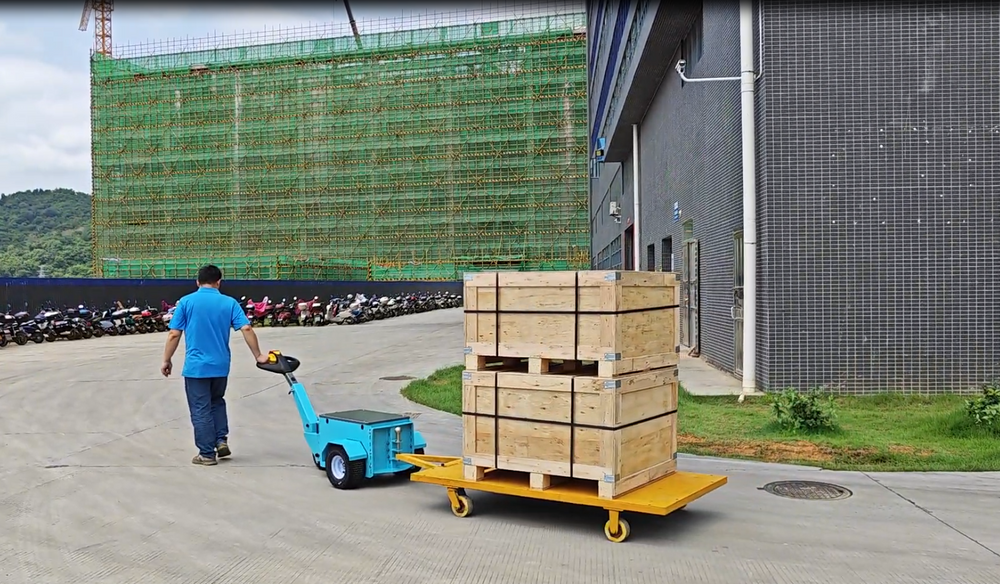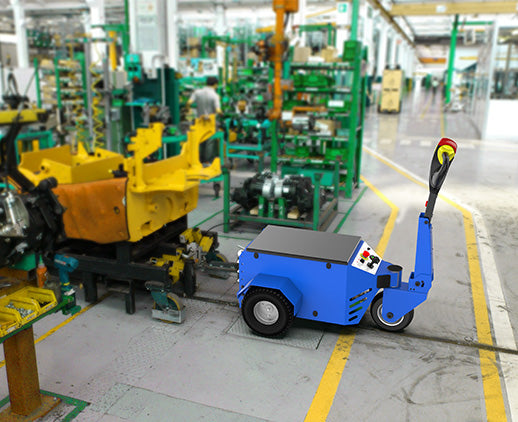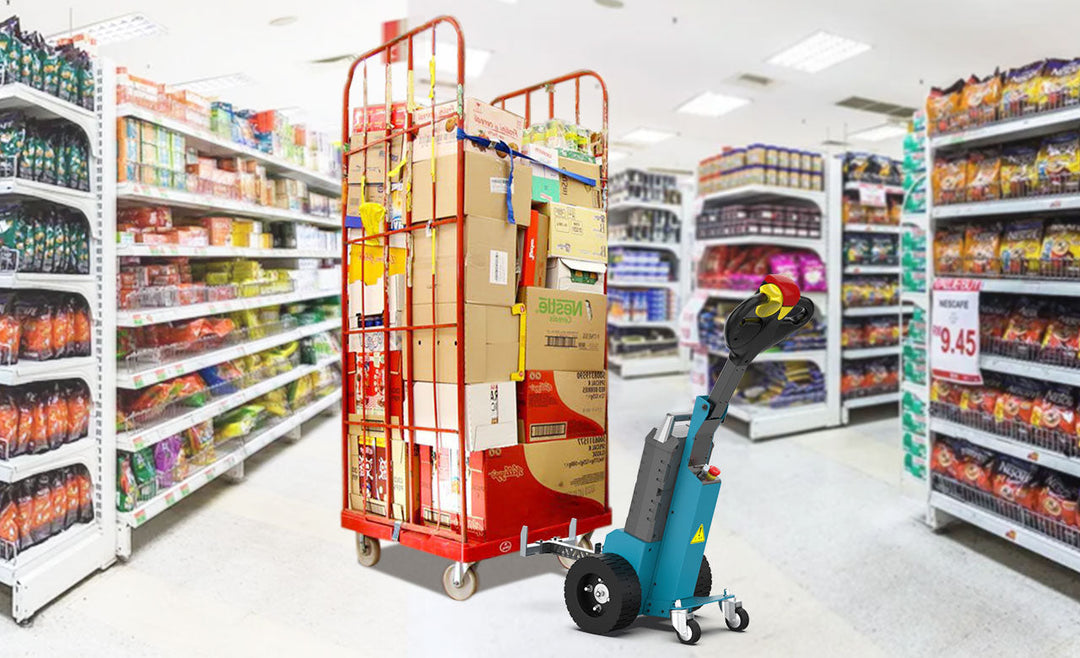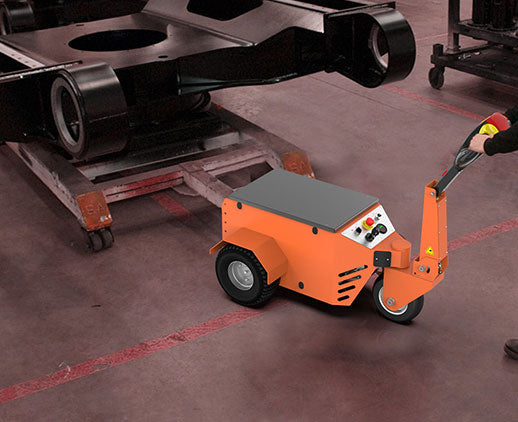Why Choose a Remote Control Tugger for Warehouses

Remote control technology allows operators to guide electric tuggers from a safe distance, reducing physical strain and improving load visibility. This enhances efficiency by 40%, cuts labor costs by 20-30%, and reduces collision incidents by 70%, making it ideal for tight spaces and low-visibility environments.
Precise Load Handling
Warehouses with remote-controlled tuggers can move goods more than 30% faster. Warehouses with remote-controlled tuggers can move an average of 2 tons of goods in 3 hours, while warehouses with traditional manual handling or forklifts need at least 4 hours. When handling items weighing up to 8 tons, these tuggers' precision handling reduces the damage rate of goods by about 15%.
Material handling accidents in the warehousing industry cause direct economic losses of more than $6 billion each year. More than 30% of injuries are caused by improper operation of traditional equipment or human error. Warehouses with remote-controlled tuggers have seen an increase of more than 40% in employee injury accidents.
50% of warehouse space is usually limited by narrow aisles and irregular shelf layouts. The design of remote-controlled tuggers allows them to easily pass through aisles that are only 2 meters wide and even turn smoothly in aisles of 1.5 meters.
Warehouses using remote-controlled tuggers have 20%-30% lower labor costs than traditional warehouses, and warehouses using electric tuggers can save about 15%-25% in energy expenses each year.
The average annual maintenance cost of traditional fuel-powered equipment is about $3,000-5,000. The annual maintenance cost of electric remote-controlled tuggers is only $1,000-1,500. The service life of electric tuggers is generally 7-10 years, compared to 5-7 years for traditional equipment.
Traditional fuel forklifts produce about 2,000-3,000 kg of carbon dioxide emissions in annual operation, while electric tuggers achieve zero emissions.
Moves High-Value Items
Globally, damage to high-value items costs more than $15 billion per year. This precision operation can reduce the damage rate of high-value items by about 30%.
When using traditional handling equipment (such as forklifts), the damage rate of high-value items is usually 3%-5%, while the damage rate of remote-controlled tuggers is only 0.5%-1%.
The remote-controlled tugger reduces the handling time of the same amount of products by 40%. In the traditional handling mode, each handling cycle takes about 10 minutes, while with the remote-controlled tugger, the cycle is shortened to 6 minutes.
The remote-controlled tugger can also provide 24/7 all-weather operation. About 30% of companies in the global warehousing industry adopt a 24-hour operation mode. Warehouses using remote-controlled tuggers can reduce labor costs by about 25% compared to traditional manual operations. The design of the remote-controlled tugger enables it to operate precisely in a 1-meter-wide aisle. This intelligent protection measure has been proven in actual operation to reduce equipment failures by 35%-40%.
Effortless Heavy Load Control
Companies that use remote-controlled tuggers have increased their efficiency in heavy-duty handling by 40%.
When handling 5-ton equipment, the tugger reduces vibration and tilting during handling by 60% through real-time load balancing adjustment.
It takes about 25 minutes to move a batch of 3-ton mechanical equipment using traditional methods. With the use of remote-controlled tuggers, this cycle is shortened to 15 minutes, increasing efficiency by 40%.
More than 40% of warehousing companies have successfully reduced labor demand by at least 20% by introducing automated equipment. In some high-load handling tasks using remote-controlled tuggers, labor cost savings are as high as 30%-50%. A logistics company uses remote-controlled tuggers to handle equipment over 10 tons, and the company saves more than $500,000 in labor costs each year by reducing manual intervention.
The flexibility of the remote-controlled tugger design enables precise operation in narrow aisles 1.8 meters wide. A large electrical appliance manufacturer has increased its operating space for heavy-duty handling by 25% by introducing remote-controlled tuggers.
There are about 1,200 accidents caused by traditional forklifts and manual handling each year, of which about 25% involve the handling of heavy objects. In warehouses using remote-controlled tuggers, the accident rate is reduced by 40%.
The average annual maintenance cost of a traditional forklift is about $3,000-4,000, while the maintenance cost of an electric remote-controlled tugger is reduced to $1,000-1,500. The service life of a remote-controlled tugger is generally 7-10 years, while the service life of a traditional forklift is generally 5-7 years. The annual carbon emissions of an electric tugger are almost zero, while traditional internal combustion forklifts may emit 5,000-7,000 kg of carbon dioxide per year.
Works in Tight Spaces
Warehouses using remote-controlled tuggers have increased their workspace utilization by 20%-30%.
The aisle width of some large storage facilities or factories is usually only 1.5 meters to 2 meters. Remote-controlled tuggers can operate safely and efficiently in aisles that are only 1.2 meters wide.
By using remote-controlled tuggers, handling time is reduced by 35%, and the damage rate of goods is reduced by 40%. Warehouses using remote-controlled tuggers have reduced the safety accident rate during heavy object handling by 50% compared with traditional methods.
In addition, the operating system of remote-controlled tuggers is usually equipped with 360-degree panoramic cameras and ultrasonic sensors. Warehouses using remote-controlled tuggers have reduced employee health risks by 40%.
A company used a remote-controlled tugger in a warehouse to move 10 tons of mechanical parts, which increased work efficiency by 50%.
Enhanced Operator Visibility
After a large warehouse introduced a remote-controlled tugger, the operator gained 100% of the environment through the real-time monitoring screen, which increased the visual operation space by more than 40% compared with the blind spots and viewing angle limitations of traditional equipment.
The tugger equipped with a panoramic monitoring system has an operating accuracy improvement of 25%. The lidar sensor and real-time video return system installed on the remote-controlled tugger help the operator clearly judge the distance between the equipment and obstacles, reducing collision accidents by 60% and reducing the downtime of the production line by 15%.
In warehouses using this technology, operators have shortened their task completion time by 20%-30%. tuggers equipped with an intelligent environmental monitoring system have reduced damage and cargo returns caused by environmental factors by 35%.
The real-time navigation system has helped operators reduce 25%-35% of misoperations. The remote-controlled tugger also supports intelligent obstacle recognition and automatic obstacle avoidance, which improves the operating safety in complex environments by more than 40%.
Equipment equipped with an enhanced visualization system has a 30% reduction in failure rate, a 25% reduction in maintenance costs, and a 20% extension in the service life of the equipment.
Single Operator Efficiency
After a large warehouse introduced a remote-controlled tugger, the operator was able to complete a task that originally required two employees and a forklift in 30 minutes. This technology improved operational efficiency by about 50%.
Warehouse operators using remote control systems found that each operator was able to operate up to four devices at the same time, which increased operating efficiency by 120% compared to traditional manual operations. The warehouse has increased the number of goods handled by more than 40% in the same working hours, while the overall operating cost has dropped by 15%.
In addition, the intelligent system of the remote-controlled tugger can automatically perform path planning and load balancing, reducing the decision-making pressure of the operator. After applying this system, a single operator no longer needs to frequently adjust the equipment's driving route, and the equipment automatically calculates the optimal route, saving a lot of time. For example, after a logistics company applied a remote-controlled tugger, the average handling time of a single operator was reduced from 45 minutes to 30 minutes, and the efficiency was improved by 33%.
The remote-controlled tugger is also equipped with an intelligent obstacle recognition system. After installing this technology, the average operating time of the operator was reduced by 20%-25%. The equipment maintenance cost was reduced by about 30%.
By implementing remote-controlled tuggers, operators were able to move 250 tons of cargo in a 10-hour workday, a 45% increase from before the technology was adopted. Companies using remote-controlled tuggers found that operators experienced 40% less fatigue and 30% less discomfort after long hours of handling.
A multinational retailer uses remote-controlled tuggers, which eliminates the need for operators to manually drive and reduces idling time. Handling operations are 25% faster. With optimized battery charging strategies, the average working time of remote-controlled tuggers has increased by 20%-30%.
Maximized Safety Features
The application of this system has reduced collision incidents in the warehouse by about 70% within a year. Accidents caused by equipment misoperation have been reduced by about 40%, and the overall risk index of the workplace has also dropped by 22%.
Through remote control operation, operators avoid directly entering the danger zone when the equipment fails, thereby reducing occupational injuries by about 30%.
The introduction of this intelligent sensing technology has reduced the employee injury rate on the production line by 35% and the accidents caused by equipment failure by 25%. The probability of failure during long-term high-load operation has been reduced by 50%.
The application of emergency brake function and intelligent reverse detection system has reduced the risk encountered by operators by about 60%, and the damage rate of equipment has also been reduced by 50%. The introduction of intelligent monitoring and alarm systems has reduced 45% of safety incidents.












